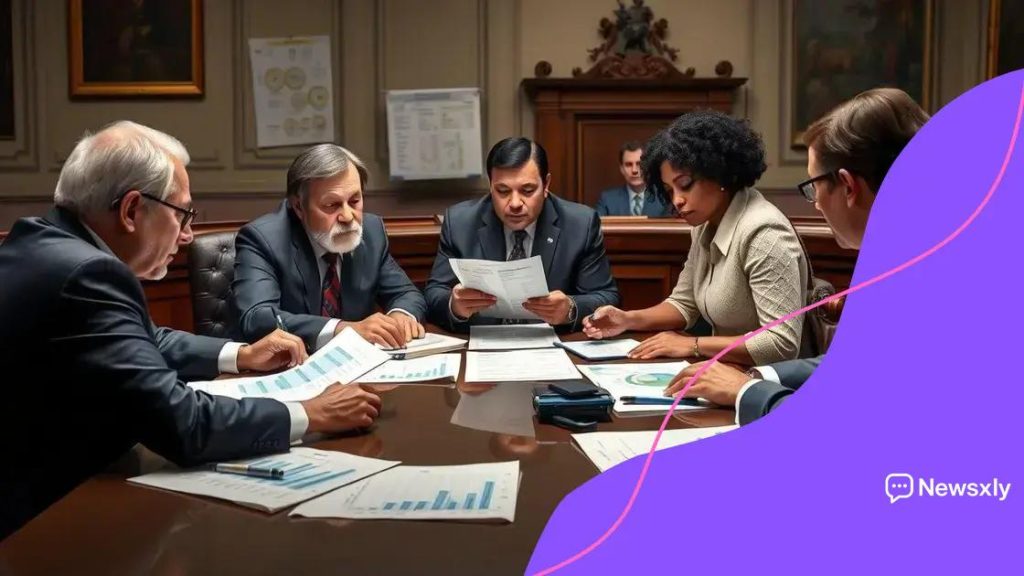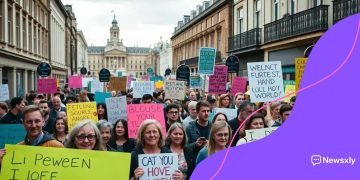US federal budget discussions and their impact on citizens

The federal budget discussions significantly impact social programs, local economies, and public well-being, with future trends focusing on sustainability, equity, and increased public engagement in the budgeting process.
US federal budget discussions and their impact extend beyond mere numbers and charts. They shape the policies influencing our daily lives, from education to healthcare. Ever wondered how these discussions trickle down to affect your community? Let’s dive in.
Understanding the US federal budget process
The US federal budget process is complex yet crucial to understanding how government funds are allocated. At its core, this process determines how taxpayer dollars are spent across various sectors, including education, health care, and defense.
The Budget Cycle
The budget cycle is an ongoing process involving several steps that ensure funds are used effectively. It typically starts in February when the President submits a budget proposal to Congress. Following this, Congress holds hearings and makes adjustments based on feedback.
- The President’s budget request
- Congressional hearings and discussions
- Approval and enactment of budget laws
- Ongoing budget monitoring and amendments
Throughout the year, different committees in Congress review these budget proposals, ensuring they meet the needs of the citizens. This is critical because it influences the federal budget decisions that affect not just government programs but also daily life.
Budget Impact on Policy
Each budget affects various policies that aim to improve social welfare. The outcomes of budget decisions can lead to increased funding for education or health services, impacting local communities. On the other hand, cuts may result in less support for essential programs.
This connection between budgeting and policy highlights the importance of public participation. Citizens can voice their concerns during town hall meetings or through local government forums, encouraging their representatives to consider community needs in the budgeting process.
Moreover, understanding the federal budget process equips citizens to better engage with their representatives. By being informed about how funds are allocated, individuals are empowered to advocate for issues that matter to them.
Key players in budget discussions
Understanding the key players in budget discussions is essential to grasp how decisions are made regarding the federal budget. The process involves various stakeholders, each with unique roles and responsibilities.
Government Officials
At the forefront are government officials, including the President and the Secretary of the Treasury. Their influence is significant as they outline budget priorities and introduce proposals that reflect their policies. Congress members also play a crucial role during the budgeting process by analyzing proposals and advocating for specific allocations.
- The President sets overall budget priorities.
- The Secretary of the Treasury manages financial resources.
- Congress members focus on community benefits.
- Committees examine proposals in detail.
Engagement from different committees such as the House Appropriations Committee helps dissect and review budget proposals. These committees ensure that all necessary aspects are considered before the budget is approved.
Advocacy Groups
Advocacy groups represent the interests of various sectors, including education, healthcare, and social services. These organizations are crucial in voicing public concerns and pushing for funding allocations that support vital programs. By lobbying Congress and raising awareness, they amplify the needs of their communities.
Moreover, the active participation of citizens can significantly impact budget outcomes. Individuals can engage with their representatives to highlight community priorities. This grassroots movement reinforces the idea that budget discussions are not merely a political matter but a public one.
The collaborative efforts among all these key players ultimately shape the final federal budget. Understanding their roles helps clarify how decisions directly affect the population.
Impact of budget decisions on social programs

The impact of budget decisions on social programs is profound and far-reaching. These choices directly influence the availability and quality of services that many individuals rely on. When the federal budget is formulated, it encompasses various social programs aimed at helping vulnerable populations, such as education, healthcare, and housing assistance.
Funding Allocations
Funding allocations significantly affect the quality and extent of social programs. When budgets are increased, programs can expand, allowing more individuals to receive essential services. Conversely, if funding is cut, many programs may face reductions in services or even closure.
- Increased funding can provide additional resources for education.
- Healthcare programs may improve access to medical services.
- Housing assistance can help families secure stable housing.
- Job training programs can offer better opportunities for employment.
These financial decisions highlight how interconnected budget choices are with the welfare of communities. For instance, a budget increase in education can lead to more teachers being hired, which in turn improves student outcomes. This exemplifies how good budget management can create a ripple effect positively impacting the community.
Long-term Effects
The long-term effects of budget cuts can be devastating for social programs. For instance, when less funding is provided for healthcare, it can severely limit access to necessary services, leading to poorer health outcomes for communities. Similarly, cuts to education can result in larger class sizes and fewer resources for students.
Moreover, budget decisions tend to reflect the government’s priorities. When social programs are underfunded, it may indicate that the needs of certain populations are being overlooked. This can result in increased inequality, as those in need of support receive less assistance, exacerbating the challenges they face in their daily lives.
Understanding the impact of budget decisions is crucial for advocating for necessary resources. Citizens can engage with policymakers to ensure that social programs receive the attention and funding they deserve.
How budget allocations affect local economies
Budget allocations play a significant role in shaping local economies. When the federal government decides how to distribute funds, it impacts various community needs such as infrastructure, education, and public services. These decisions help create an environment for economic growth.
Investment in Infrastructure
Investment in infrastructure is one of the most direct ways budget allocations can affect local economies. When local governments receive funding for roads, bridges, and public transit, it opens doors for businesses and improves accessibility for residents. Improved infrastructure leads to job creation and attracts new companies to the area.
- Better roads reduce transportation costs for businesses.
- Improved public transit connects workers to jobs.
- Upgraded facilities can boost tourism.
- Investment in technology enhances communication services.
The quality of infrastructure can dictate the overall economic health of a community. For example, cities with well-maintained services often see more businesses thriving within their borders.
Education and Workforce Development
Another crucial area influenced by budget allocations is education. When budgets prioritize education, it directly benefits local economies. Quality schools provide students with the skills they need for future job opportunities. Increased funding can lead to smaller class sizes, better resources, and more extracurricular programs.
Skilled workers contribute to a stronger labor market and can attract businesses looking for competent employees. Educated populations are often linked to lower unemployment rates, which gives local economies a boost.
Additionally, budget decisions affect community services that support low-income families. When funds are available for social programs, they help provide essential support, which in turn can stabilize local economies. Ensuring families have access to adequate healthcare, housing, and nutrition positively influences productivity and overall economic stability.
By understanding how budget allocations impact local economies, citizens can advocate for policies that prioritize essential community services and infrastructure improvements. Engaging in budget discussions allows community members to express their needs and influence future funding decisions.
Future trends in federal budget discussions
Future trends in federal budget discussions are evolving as society changes and new challenges emerge. These trends reflect the need for adaptable policies that address contemporary issues like climate change, healthcare access, and income inequality.
Emphasis on Sustainability
One significant trend is the growing emphasis on sustainability within budget allocations. As environmental concerns become more pressing, lawmakers are looking to fund projects that promote renewable energy and conservation. This shift not only addresses climate change but also creates jobs in emerging industries.
- Investments in clean energy sources.
- Funding for public transportation to reduce emissions.
- Support for sustainable agriculture practices.
- Grants for community-based environmental initiatives.
These sustainable practices in budgeting are crucial as they help build a resilient economy that safeguards the future.
Increased Public Engagement
Another trend is the push for increased public engagement in budget discussions. More communities are advocating for transparency and active participation in how budgets are created and allocated. Town hall meetings and online platforms enable citizens to voice their priorities and concerns.
This engagement fosters accountability and ensures that the government reflects public needs in its spending decisions. Citizens can now easily access budget documents and provide input on how funds should be spent.
Focus on Equity and Inclusion
Future budget discussions increasingly focus on equity and inclusion. Policymakers are urged to consider the impact of budget decisions on marginalized communities. Allocating funds to address disparities in education, healthcare, and housing can create a more equitable society.
This trend towards inclusivity helps to ensure that all citizens benefit from government services and resources, fostering a sense of belonging and community.
Overall, the future of federal budget discussions will likely involve a combination of sustainable practices, public involvement, and a focus on equity. Understanding these trends is vital for citizens who want to engage meaningfully with the policymakers shaping their financial futures.
FAQ – Common Questions About Federal Budget Discussions
What is the federal budget process?
The federal budget process involves multiple steps, including proposals, reviews, and approvals by various government officials and Congress.
How do budget allocations impact local economies?
Budget allocations directly influence local economies by funding infrastructure, education, and social services, which support community development.
Who are the key players in budget discussions?
Key players include government officials like the President and Congress members, advocacy groups, and citizens who voice their needs.
What trends are shaping future budget discussions?
Future budget discussions are focusing on sustainability, increased public engagement, and promoting equity among communities.





